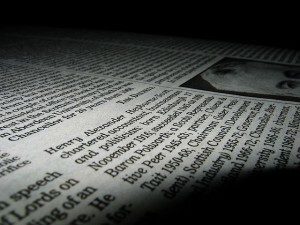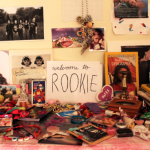Bringing the obituary to life
“The Internet can bring an obituary to life.” It may sound like a contradiction, but this is what Barbara Stewart took away from a fourth-year course taught at the University of Victoria
“The Internet can bring an obituary to life.” It may sound like a contradiction, but this is what Barbara Stewart took away from a fourth-year course taught at the University of Victoria by The Globe and Mail’s chief obituary writer, Sandra Martin.
Martin has been covering the dead beat at the Globe since 2004. Four years after she took this job—arguably making a morbid career change, switching from her longtime position as an arts and culture writer—she wrote that her profession was on life support, and not solely due to cutbacks in the business. “Modern technology and the Internet are having a radical impact on how we, as a society, commemorate a life,” Martin wrote, “and it’s not all for the good.”
Four years later, Martin says she’s now much more optimistic about the obituary—as long as newspapers develop their websites, exemplified by The New York Times’s obituary section, which features archived pieces, videos, and photo galleries.
In keeping with this approach, Martin focused her course on biographical writing in the digital age when she taught Stewart and about 50 others as University of Victoria’s Harvey Stevenson Southam Lecturer in 2009. Her students were responsible for creating a website featuring an obituary that included multimedia components. “If you’re writing an obituary for Oscar Peterson, how great it would be to have some of his music so you can hear it,” Martin says. “Those types of things can really enhance obituaries. Easier than having to describe how someone plays; you can illustrate it.”
Still, one of the things Martin continues to worry about is the prospect of just anyone posting online. “It’s a sort of free-for-all of who’s dead today. That kind of frenzy about reporting, and often inaccurately reporting, that people are dead, when they aren’t.” Case in point: the many celebrities whose “deaths” begin with a rumour and often end with news reporters’ retractions. In September 2010 for example, NHL coach Pat Burns was pronounced dead by major news outlets, including CTV and TSN, two months before his actual death. The message to journalists: it’s not always best to be the first to break a story.
Nonetheless everyone wants to be first in a technology-driven world where smartphones in the hands of journalists are a given and the constant updating of social media applications is expected. However, Martin notes that it’s important to make clear the distinction between a news report that someone has died and an obituary. Twitter is just fast and brief, whereas an obituary is a written discursive form, she says.
Krishna Andavolu, managing editor of Obit, an online magazine that “examines life through the lens of death,” says the online obituary—if thought about in expansive terms—can include anything from a Twitter post, to a Facebook status update, to a blog post. “What you see now is a shorthand of ways people express their feelings right off the bat when someone dies,” Andavolu says. “Social media has taken over with the RIP, the shorthand for ‘this person is dead.’ So if you look at the obituary technically as a death notice, or that which communicates news of a person’s death, then that death notice has become less of a recording of the history and more of a recording of how people are reacting to that death.”
Andrew McKie, former obituary editor for The Daily Telegraph, also stresses the difference between reporting a death and writing an obituary, pointing out, “There’s now this tension between being able to do a good job and being able to do a quick job.” He says reporting Elizabeth Taylor’s death would read something like: “‘Elizabeth Taylor has just died. She was a famous actress who had been married umpteen times,’ and so on. I think an obituary is a totally different thing. It’s like an essay. It’s got to be a comprehensive biographical account of a life,” McKie says. “They are not needed to be done elegantly and beautifully and well and fast. I mean, it was my job to do them elegantly and beautifully and fast on occasion. But there’s a big difference between being in the office at five o’clock at night and having three hours starting from scratch to turn out 3,000 words about somebody, and being asked to do it in 15 minutes from home. And of course the thing that makes people think that it’s possible to do it in 15 minutes from home is that so much information is available online.”
This hints at another aspect of the internet that is both a gift and a curse for obituary writers: its effect on their research process. Alana Baranick, director of the Society of Professional Obituary Writers, says while research is easier and faster, obituary writers still need to evaluate whether content found online is legitimate, and to ensure they add context. “I think in some cases it makes reporters lazy, and that applies to all forms of news. I personally have known a lot of younger reporters who have been using the Internet since they started, who oftentimes just pick up on something they found online without considering the whole picture,” Baranick says, citing the death of Penn State football coach Joe Paterno, who was implicated in the child sexual abuse case against his former colleague, Jerry Sandusky. “The current controversy was a big part of his story, but the man was a legend. If he had lived another 10 years, I wonder how prominent the controversy would be in his obituary, because he wasn’t really the person who committed the crime.”
One of the major impediments to producing authoritative work is use of the Internet as the only research tool, McKie says. The web, along with LexisNexis and various subscription services, has come to replace physical libraries filled with the hundreds of carefully fact-checked reference books that used to be present in newspaper offices.” But, he believes, “Actually they’re not as good,” citing the overwhelming amount of content, a lack of context and unreliable sources as reasons for his assertion.
“You can’t just trust anything you read on the Internet, but you really can hear things faster,” Martin says. She provides this advice for those interested in covering the dead beat: “I would bring all my internet skills, all my multivisual skills, because that’s what obituaries need. That’s exactly what I would do, and that’s what I try to do, too.” She also emphasizes the importance of getting it right: “The obituary is really about the life of the dead. The death is the only occasion for writing the story of a life,” Martin says. “You’re never going to write that story again.” This is a point she obviously drove home to her students at UVic: “It’s a one-shot deal, there’s no comeback,” Stewart recalls learning. “An obituary is—pardon the pun—the last rite.”
McKie agrees: “Part of an obituary is that it is a snapshot of a moment in time when a person dies, and it’s not about death, it’s about a life. It’s about providing a view of that person’s life, as it is understood by the writer,” he says. “We don’t want to revise this.”















